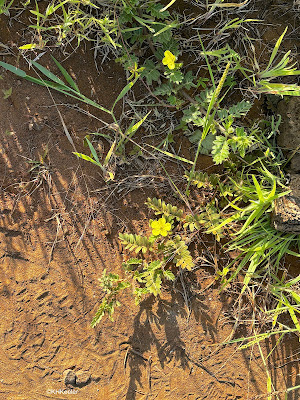On my recent trip to the Galapagos I joined park rangers on hikes, and usually I was a laggard. I kept stopping to see the plants. The rest of the group hopped from one animal photo op to the next. I tried to keep up but did a bad job of it.
 |
| the endemic tree cactus Opuntia galapagela |
Just like its animals, the Galapagos's plants include many that are unique and that differ from their mainland relatives and between islands.
My tour (Minnesota Landscape Arboretum, Knowmad Adventures and GoGalapagos cruises) only had time for five islands and was not focused on plants, so I can't show you plant variations, which are part of what makes the Galapagos special. However, these are dry volcanic islands close to the Equator, so their vegetation was fascinating.
Some are common plants from around the world, for example, portulaca (Portulaca oleracea, portulaca family Portulacaceae) and sea purslane (Sesuvium portulacastrum, ice plant family, Aizoaceae) and yet often, as is the case for Portulaca and Sesuvium, they have closely related species that are unique to the Galapagos. I needed more time and better books to identify the natives.
 |
| sea purslane (Sesuvium portulacastrum) |
A bit farther inland, the sandy or gravelly soil supports a wider range of plants. Puncture vine (Tribulus cistoides, puncturevine family, Zygophyllaceae, below) looked very like its relative from sandy soils in Nebraska. It is a common plant of trampled areas in the American tropics. The yellow flower is pretty but the seed comes in a hard green spiked fruit, tough enough to puncture bicycle tires. I did not see ripe fruits when I was there in early May.
 |
| Puncture vine (Tribulus cistoides) |
Another plant that I saw I thought was the widespread shrub lantana, Lantana camara (vervain family, Verbenaceae), which has very attractive flowers in many colors but has become an international weed. However, when I looked it up, I found the white flowered lantana of the Galapagos is Lantana peduncularis which is endemic to the Galapagos. Really a pretty plant.
 | |
lantana Lantana peduncularis |
ground cherry, Physalis species
Farther back from the coast, there were shrubs taller than I am, with round bright green leaves and dramatic yellow flowers. This was yellow cordia, Cordia lutea (borage family, Boraginaceae), a plant of the Pacific Coast of South America that I first saw in Costa Rica in the 70s. They were not flowering much when I saw them, so my photo does not do it justice, because the livid yellow blossoms can cover the whole top of the plant.
 | |||
| yellow cordia, Cordia lutea |
These are two small plants of senna, Senna pistacifolia (pea family, Fabaceae), but they grew to be tall trees. The flowers are a bright yellow and you can see the long thin pods developing. Found in South America, they are considered native to the Galapagos, where they are common.
 |
| senna, Senna pistacifolia |
 |
| common grass |
 | ||
| Galapagos cotton, Gossypium darwinii |
 |
Darwin Foundation website https://www.darwinfoundation.org/en/ A searchable database to check or help identify Galapagos animals and plants.
Scholfield, E. K. 1984. Plants of the Galapagos Islands. Universe Books, New York. Many of the names have changed but the sketches and descriptions are very helpful.
Kathy Keeler




The grass looks like Chloris gayana
ReplyDelete